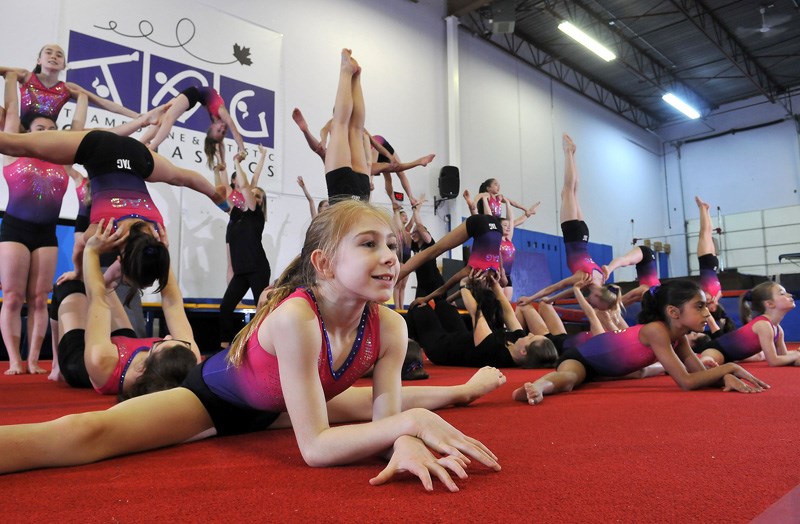When the gymnasts at TAG Sports Centre in Port Coquitlam need a break from their 10 to 12 hours of training a week, it only makes sense they do… more gymnastics.
Or rather, gymnaestrada.
While tumbling across the floor, balancing on the beam and hurling around the uneven bars is largely an individual pursuit, gymnaestrada is a team activity that can involve as few as 10 gymnasts or as many as 100 and more. It’s also more performance than competition, says TAG’s head coach, Barb Fraser, although only the best, most precise teams get to advance from regional to national to world events.
On May 12-13, TAG will be hosting 2018 BC Gymnaestrada, a weekend of workshops to introduce newcomers to the sport and hone the abilities of those already enjoying it, followed by a day of performances at the Port Moody Rec Centre by more than 500 gymnasts from across the province. The event is a precursor to 2018 Canadian Gymnaestrada at the Richmond Olympic Oval at the end of June. The best teams there could earn their way to World Gymnaestrada 2019 in Austria next July. Like the Olympics, that event is held once every four years, but its 20,000 or so participants dwarfs the international Games.
Fraser said gymnaestrada is gymnastics for everyone. Indeed, her team of 36 also includes the coaches and even some parents who take their place in the ranks of participants. The tightly-choreographed performances last anywhere from 3.5 minutes for smaller teams to 15 minutes for large groups.
Set to music, a performance can incorporate standard gymnastic moves like tumbling, twirls and jumps but more imaginative teams also work in Rube Goldberg assemblies of ribbons, mats, beams and high bars. Setting up and removing those pieces of equipment must be integrated into the routine.
“There’s no rules, no limitations,” Fraser said. “It’s unique.”
The diverse range of ages, skills, and size of the participants on a team can create challenges for choreographing a routine, Fraser said. So performances will often include busy, active stretches where everybody on the team is moving, interspersed with dance formations that allow some of the athletes to take a break. But that doesn’t mean they’re slacking off.
“There really isn’t any downtime,” Fraser said.
While gymnaestrada is still relatively unknown in North America, it’s hugely popular in Europe, Fraser said. In fact all 15 of the World Gymnaestrada events since the first one in Rotterdam in 1953 have been staged in European countries. The 2015 event in Helsinki, with 21,000 gymnasts, was the largest event in terms of participants ever held in Finland.
Fraser said the emphasis at the large-scale international event is more on entertainment and spectacle. While smaller teams will display their routines in a packed gymnasium or arena, larger teams perform in outdoor stadiums and the event culminates with a mass choreographed performance of all participants that fills a soccer pitch from end to end, sideline to sideline.
It’s that group dynamic that makes it fun for individual competitive gymnasts who get a chance to bond and perform with their teammates.
“It really brings the kids together,” Fraser said.
For more information about the Gymnaestrada event in Port Moody, including a schedule of workshops and performances, go to https://www.gymbc.org/events/events/post/722



